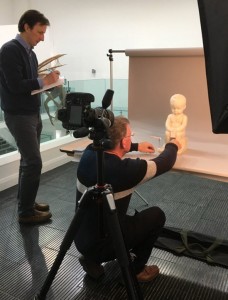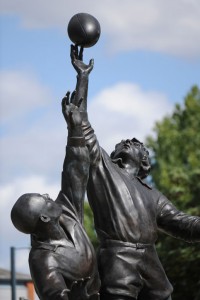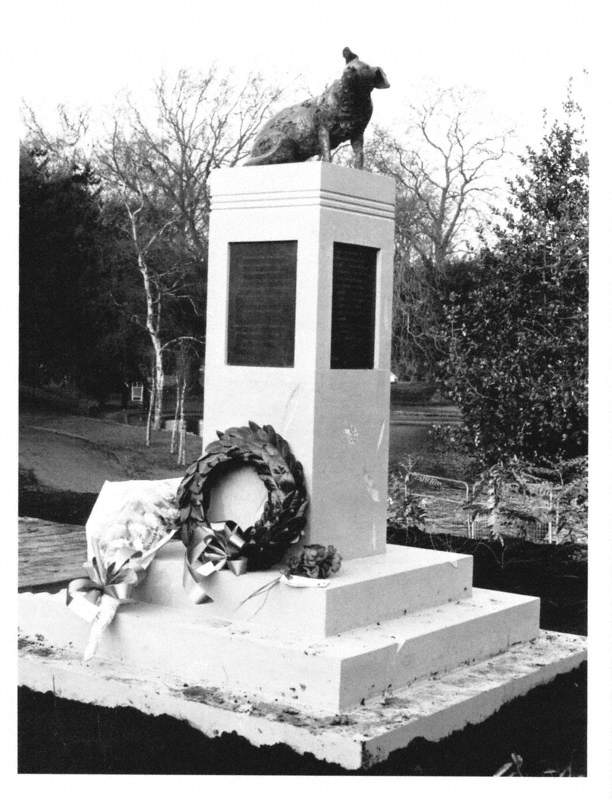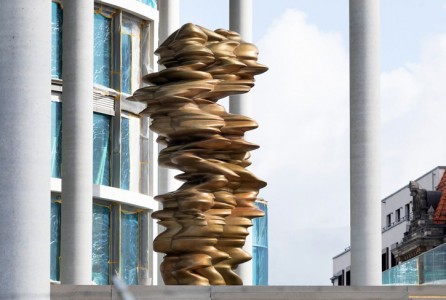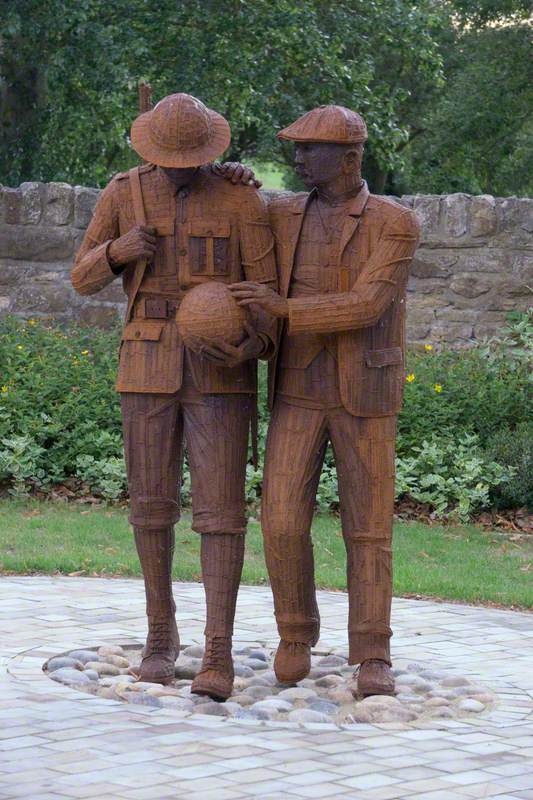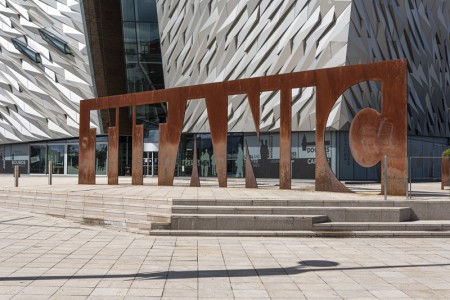Most villages and towns across the UK have a memorial to the men and women who died in the First World War. The majority were put up in the years after the conflict as a public focus for mourning and commemoration.
In more recent years, with events such as the First World War centenary, many new sculptural memorials have been produced which offer new perspectives on the overwhelming sense of tragedy and loss that continue to characterise the conflict.
Lady in the Park, Newcastle-under-Lyme, Staffordshire

© the artists. Image credit: PM Training
Lady in the Park
2014, steel, designed by Andy Edwards and made by PM Training and Realise
This life-sized sculpture in Brampton Park, Newcastle-under-Lyme, depicts a woman reading a letter informing her that a family member has been killed in action. The inspiration for the woman was Vera Brittain (1893–1970), who was born in Newcastle-under-Lyme and worked as a Voluntary Aid Detachment (VAD) nurse for much of the First World War. Brittain's best-selling memoir Testament of Youth (1933), described her experiences during and after the First World War, which saw the loss of her brother, fiancé and some of her closest friends.

© the copyright holders. Image credit: Michael Kentish / Art UK
Andy Edwards (b.1964) and Callum Marchese (b.1998)
Brampton Park, Newcastle-under-Lyme, StaffordshireA plaque beside the sculpture has a quote from Brittain's Testament of Youth:
'I sat in a tree-shadowed walk called the Brampton and meditated on the War. It was one of those shimmering autumn days when every leaf and flower seemed to scintillate with light, and I found it very hard to believe that not far away men were being slain ruthlessly. It is impossible, I concluded, to find any satisfaction in the thought of the destruction of men whether they be English, French, German or anything else, seems a crime to the whole march of civilisation.'

© the artists. Image credit: Jonathan Statham
Lady in the Park
2014, steel by Andy Edwards and made by PM Training and Realise
Unveiled in November 2014, Lady in the Park was installed to commemorate the centenary of the start of the First World War. Commissioned by Newcastle-under-Lyme Borough Council and made by PM Training and the Realise charity, the sculpture was fabricated from 200 sheets of steel formed into lifelike features and drapery, then treated to resemble bronze. The statue was designed by local sculptor Andy Edwards.
Peace Bench, Peace Garden, Alexandra Park, Hastings
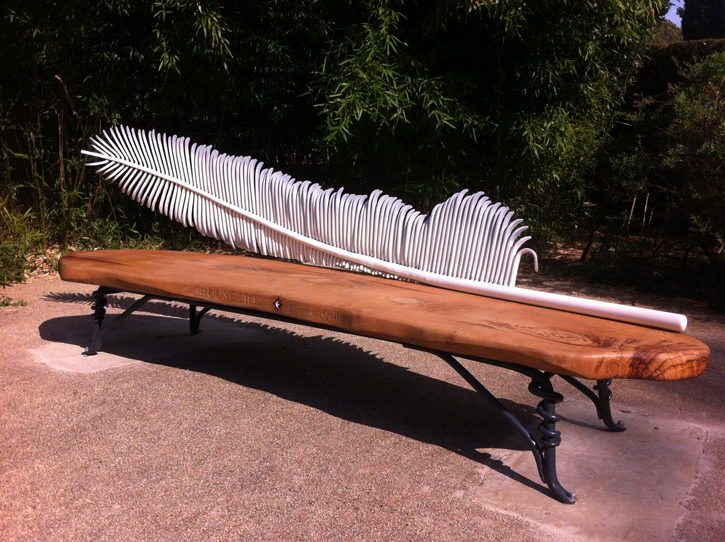
© the artists. Image credit: Jake Bowers
Peace Bench
2014, wood and steel by Alan Wright and Jake Bowers
This bench takes as its inspiration the white feather, a symbol of alleged cowardice during the First World War.
Designed by Quaker and artist Alan Wright and made by Thirsty Bear Forge blacksmith Jake Bowers, this striking Peace Bench has 150 blacksmith-forged white feathers forming the backrest. Unveiled on 21st September 2014, World Peace Day, the bench was donated by the Local Meeting of the Religious Society of Friends (Quakers), Hastings, to mark the centenary of the outbreak of the First World War.
'CHOOSE LIFE', a biblical quote (Deuteronomy 30:19), is carved on the front edge of the seat.
Shot at Dawn, National Memorial Arboretum, Staffordshire

© the artist. Image credit: Harry Mitchell, CC BY 4.0
Shot at Dawn
2000 (unveiled 2001), concrete by Andy DeComyn
Shot at Dawn commemorates the 309 British and Commonwealth soldiers executed after courts-martial for desertion and other capital offences during the First World War. The memorial depicts a blindfolded British soldier, tied to a stake and ready to be shot by a firing squad. The memorial was modelled on the likeness of 17-year-old Private Herbert Burden, who lied about his age to enlist in the armed forces and was later shot for desertion. The sculpture is surrounded by a semicircle of stakes, each of which bears the names of an executed soldier.
The memorial was created by Andy DeComyn in 2000 as a gift to the relatives of the men executed in this way. It was unveiled at the National Memorial Arboretum in 2001.
Eleven-O-One, Seaham, County Durham

© the artist. Image credit: Simon Woodley
Eleven-O-One
2014, corten steel by Ray Lonsdale
Created by sculptor Ray Lonsdale, this larger-than-life statue depicts a First World War soldier finally at rest after the end of the war. Its name references the first minute of peace as the armistice came into force at 11 am on 11th November 1918. The statue is also known as Tommy, referring to the slang name for a typical private soldier, 'Tommy Atkins'.

© the artist. Image credit: Simon Woodley
Eleven-O-One
2014, corten steel by Ray Lonsdale
The statue was displayed temporarily on Seaham seafront in 2014 but was so popular that a group of local people raised funds to buy it and create a permanent installation.
Ghost Soldiers, UK-wide
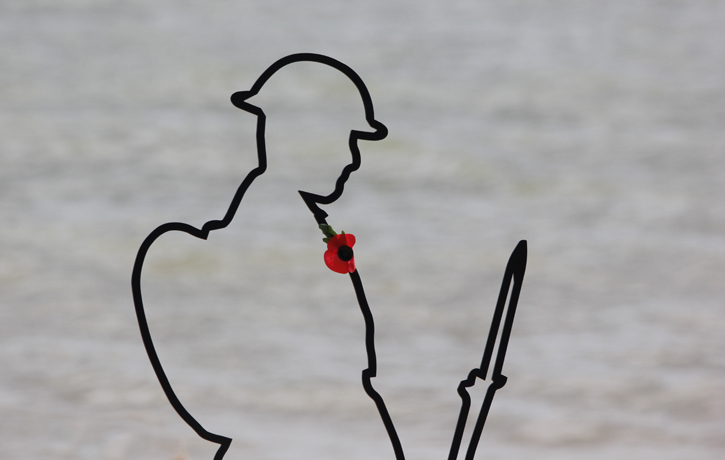
© the artist. Image credit: Tracy Jenkins
Ghost Soldier on Clacton Beach, Essex
2018, steel
As the centenary of the end of the First World War approaches, the ghostly outlines of soldiers have been appearing across the UK as part of a nationwide art installation called There But Not There. The six-foot-high silhouettes are touring the country and have already been seen at the Tower of London, the Giant's Causeway and at the white cliffs of Dover.
The campaign, run by the charity Remembered, aims to commemorate those who died during the First World War and to educate all generations, particularly younger people, to understand what led to the deaths of almost one million British and Commonwealth personnel. They also hope to raise £15 million for armed forces and mental health charities by encouraging communities to purchase and install their own silhouettes of local casualties for the 2018 Festival of Remembrance.
There But Not There is one of a number of art projects commemorating the 100th anniversary of the First World War. 14–18 NOW has commissioned over 325 artworks, which have been seen by more than 30 million people, since the start of the First World War Centenary in 2014. These include the installation of ceramic poppies that has been touring the country since 2015 and the 'dazzle ships' moored on the rivers of Liverpool, Edinburgh and London.
"My father’s grandfather was a conscientious objector; on the other side, my great-grandfather was in the trenches, and suffered his entire life from the after-effects." #TurnerPrize winner Rachel Whiteread talks about her permanent sculpture Nissen Hut. https://t.co/TOLjukOT4w pic.twitter.com/OkBSiFFjhD
— 14-18 NOW (@1418NOW) January 23, 2019
In 2018, new commissions include Nissen Hut by Rachel Whiteread installed in Yorkshire's Dalby Forest and the new statue by Gillian Wearing of leading Suffragist campaigner Millicent Fawcett in Parliament Square, London.
The devastation caused by the First World War affected every family in the country, with millions killed. A hundred years on we continue to say – whether by wearing a poppy, or by very public monuments to remembrance – we will remember them.
Katey Goodwin, Art UK Deputy Director and Head of Digitisation and Public Engagement

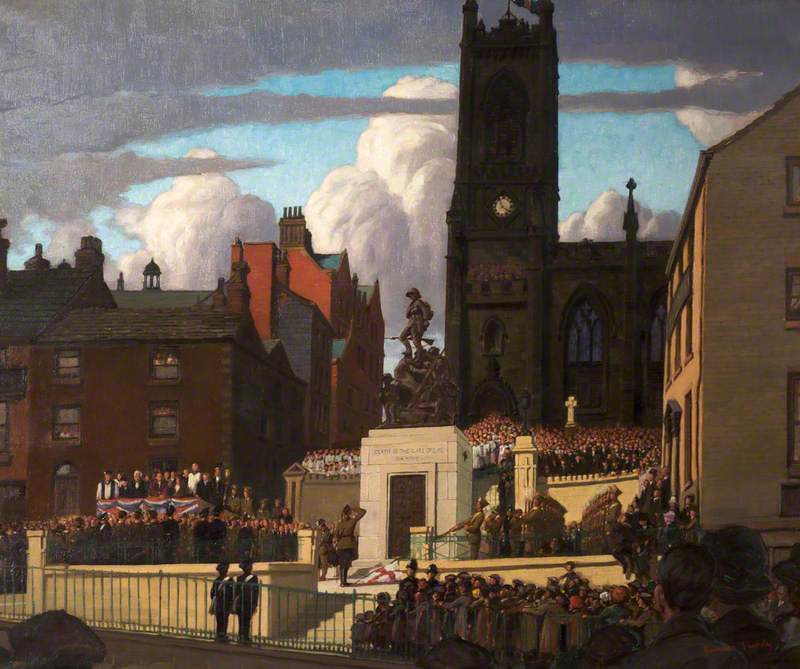
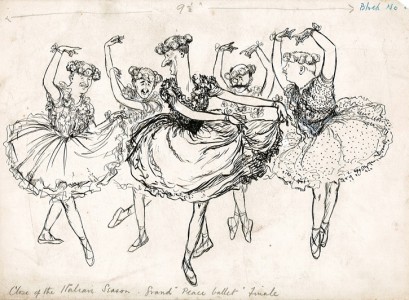




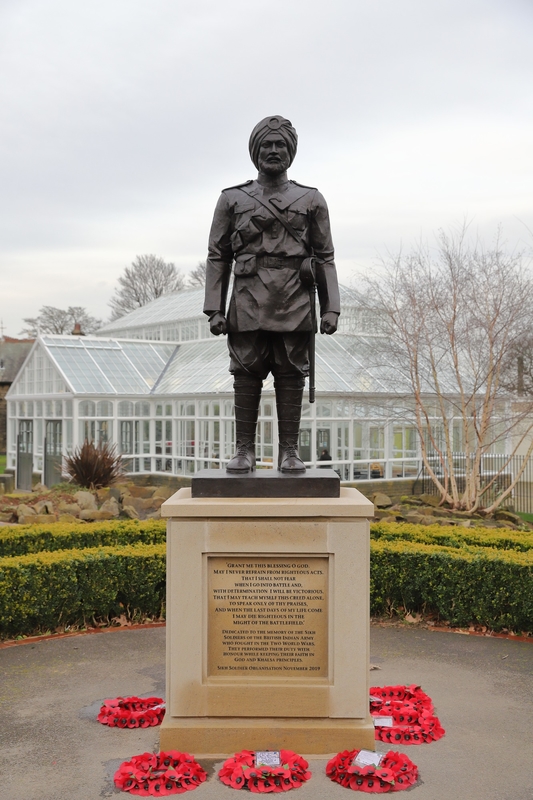

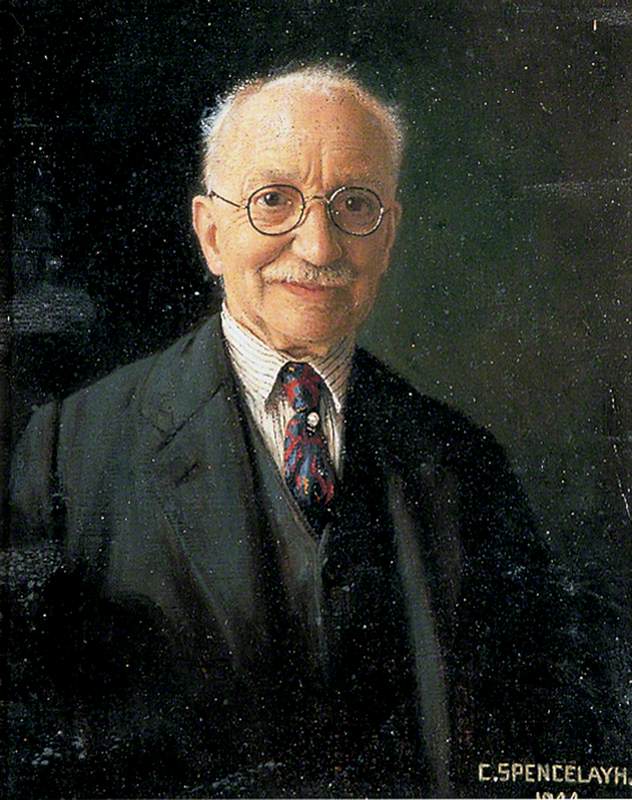
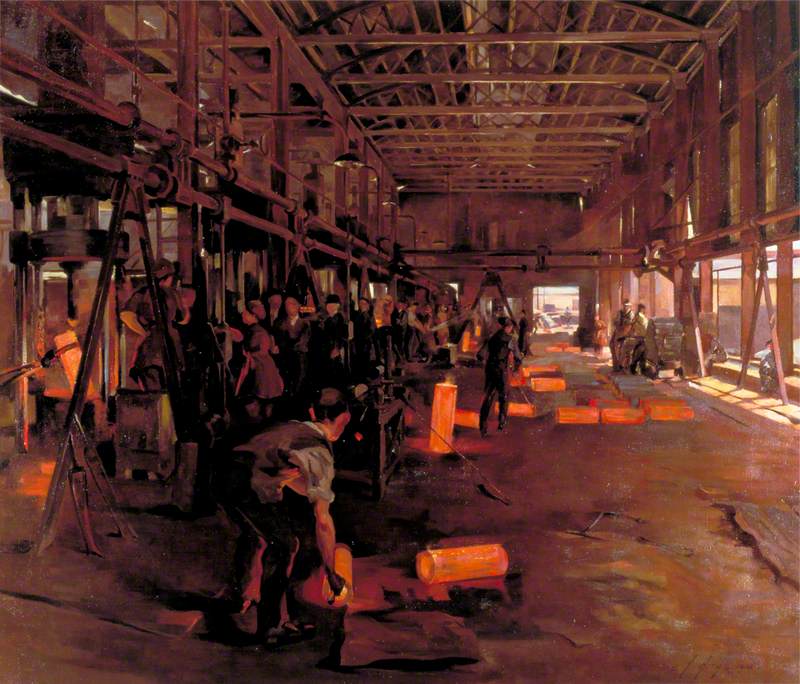

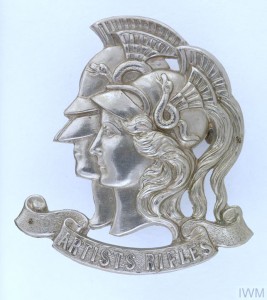




















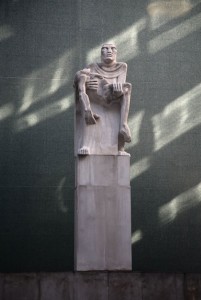




.jpg)




